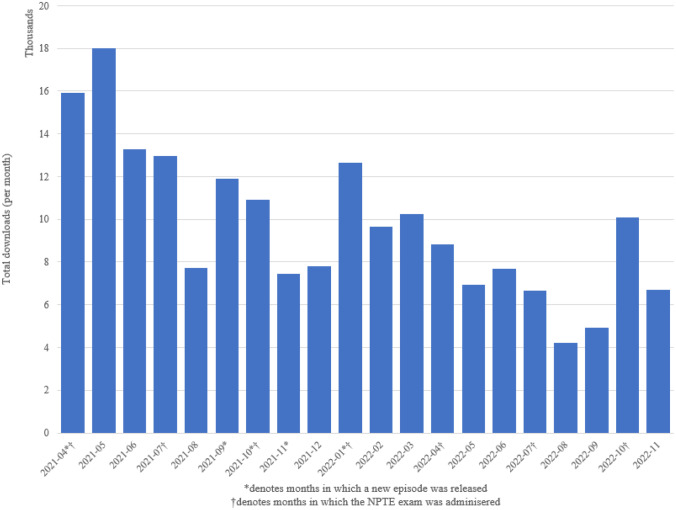Abstract
The National Physical Therapy Examination (NPTE) is the gold standard for aspiring physical therapists. The NPTE Studycast is an innovative way for physical therapy students to prepare for the NPTE. The NPTE Studycast combines recorded information and content questions in a quiz format. To date, the podcast is widely downloaded.
Keywords: Podcast, Physical therapy, NPTE, Technology, Education
Introduction
The aim of this teaching innovation was twofold: to create an educational platform that combined the elements of games with anatomical content and to increase the accessibility of anatomical content to students. “Clash of the Craniums” is a portion of the NPTE Studycast, an Internet-based trivia game that was hosted once per month and recorded. The National Physical Therapy Examination (NPTE) remains the gold standard for demonstrating academic and clinical competencies among physical therapy students in the USA. Several studies have hypothesized predictor variables for success on the NPTE and have analyzed factors such as GPAs and GRE scores, amongst other variables. Few studies have analyzed student study habits or resources as a predictor variable of success on the NPTE [1].
Background
According to the Physical Therapist Centralized Application Services (PTCAS) aggregate data, the average physical therapy student in the USA is 24 years old. If they were to enroll in a physical therapist education program in 2022, the birth year of the typical physical therapy student is between 1999 and 2001, placing them in the category of digital natives. A digital native is a person who has had technology available throughout their entire life. Digital natives are versed in the use of technology but also expect it to be an integral tool in their daily lives, including education. Classroom technology use has increased dramatically in the last 30 years, as have higher education alternative teaching styles. Today’s classroom showcases techniques such as flipped classrooms, user feedback devices like classroom clicker response systems, and Internet-based quizzes [2].
The current literature has demonstrated that game-based learning increases learner engagement and immerse them in a learning environment, leading to improved performance. Current literature validates the use of technology such as Snapchat to disseminate anatomical concepts to students [3]. Existing study resources for the NPTE exist of synchronous and asynchronous courses and prefabricated practice examinations. Existing study resources are valuable tools that have been proven throughout the history of the NPTE. However, all are limited by the need for the student to engage with the content visually. The proposed teaching innovation allows students to engage with the content in a non-visual platform, thus allowing the student to access the content while using transportation or other activities that preclude them from viewing a screen.
Methods
All recordings were repurposed into podcasts that were accessible via a web-based device. Between April 2021 and November 2022, the NPTE Studycast has been downloaded 194,674 times with 88% of downloads converting into an impactful podcast play. An impactful play podcast is defined as a podcast that was listened to for at least 75% of its content, thus discriminating it from a download that was downloaded but never listened to [4]. Figure 1 displays the total number of downloads from April 2021 until November 2022. The table demonstrates download spikes that the authors attribute to creating new podcast content during that period and time proximity to the administration of the NPTE exam. The NPTE exam is administered quarterly in January, April, July, and October [5]. As this teaching innovation is in the development stages, the researchers intend to analyze the effectiveness of NPTE performance in future research.
Fig. 1.
Podcast downloads per month
Trivia questions are centered on an anatomic region such as the upper arm and brachial plexus, heart, lung, and hip regions. Each monthly episode consists of 20 questions written by one of the authors. Each question is derived from Gray’s anatomy for students. Participants are given 20 s to answer each question. Questions are delivered in a multiple-choice format with a correct answer and two distractors. The hosts chose this format due to the shorter time to answer questions. Trivia questions were delivered in visual and auditory formats, allowing participants to answer questions live and compete against other participants. Each question ended with the correct answer displayed and an explanation of the rationale of the correct answer.
Discussion
The podcast combines two existing technologies: games and recorded information into an educational platform. Podcasts could serve as a suitable adjunct to traditional standardized testing preparation. The quiz game-style questions give the user time to think and choose answers while providing the correct answer to the question and a rationale and explanation of the correct answer. The podcast platform allows anyone who can listen to a podcast, regardless of physical therapy program attended or other affiliation, to access the content. The authors see the potential for the podcast to be extended to such areas as clinical specialist certification exam preparation, jurisprudence examination preparation, or other examinations.
Declarations
Conflict of Interest
The authors declare no competing interests.
Footnotes
Publisher's Note
Springer Nature remains neutral with regard to jurisdictional claims in published maps and institutional affiliations.
References
- 1.Wolden M, Hill B, Voorhees S. Predicting success for student physical therapists on the national physical therapy examination: systematic review and meta-analysis. Phys Ther. 2020;100(1):73–89. doi: 10.1093/ptj/pzz145. [DOI] [PubMed] [Google Scholar]
- 2.Shenson JA, Adams RC, Ahmed ST, Spickard A. Formation of a new entity to support effective use of technology in medical education: the student technology committee. JMIR Med Educ. 2015;1(2):e9. Published 2015 Sep 17. 10.2196/mededu.4676. [DOI] [PMC free article] [PubMed]
- 3.Pascoe MA. The effect of Snapchat on learner satisfaction and anatomical knowledge retention: preliminary observations. FASEB Bioadv. 2021;3(11):909–917. Published 2021 Aug 27. 10.1096/fba.2021-00052. [DOI] [PMC free article] [PubMed]
- 4.Podcast Statistics. Bluburry Podcasting. https://blubrry.com/services/podcast-statistics/. Accessed 3 Mar 2023.
- 5.National Exam (NPTE). Federations of State Boards of Physical Therapy. https://www.fsbpt.org/Secondary-Pages/Exam-Candidates/National-Exam-NPTE. Accessed 3 Aug 2022.



